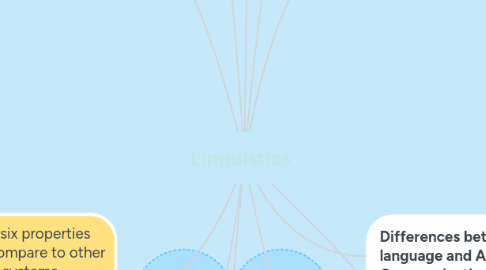Linguistics
作者:Hector Vigil

1. The Study of the properties of Human Language
2. Properties of H. Language
2.1. Reflexivity: Allows humans to understand signs, sounds, or expressions that we use in a daily basis.
2.2. Displacement : Allows humans to talk about things and events not present in the immediate environment.
2.3. Arbitrariness: It is generally the case, when there is no ¨natural¨connection between a linguistic form and its meaning .
2.4. Productivity : this property means that the potential number of utterances in any language is infinite.
2.5. Duality:Human Language is organized in two levels. We have distinct sounds, and, at another level, we have distinct meanings.
2.6. Cultural Transmission: Languge is not something a person can inherit from his/her parents, we adcquire a language in a culture with other speakers, and not from parental genes.
3. There are other six properties often used to compare to other communication systems.
3.1. vocal-auditory channels use: Language signals are sent using the vocal organs and received by the ears
3.2. Specialization: These types of language signals do not serve any other type of purpose such as breathing or feeding.
3.3. non-directionality : These language signals have no inherent direction and can be picked up by anyone within hearing, even unseen.
3.4. Rapid face: These language signals are produced and disappear quickly.
3.5. Reciprocity: In this property , any sender of a language signal can also be a receiver.
3.6. Prevarication: In these property, language signals can be false or used to lie or deceive.
4. The Linguistics study multiple features of the human language
4.1. kjfksfkfjksD
5. Sounds
5.1. Phonetics
5.2. Phonology
6. Structure
6.1. Morphology
6.2. Syntax
7. The Study of Human Communication and its roots
8. Communicative skills
8.1. When we use Language to tell someone something about us. We are then considered to be intentionaly communicating something.
9. imformative Signals
9.1. When someone become informed about you through a number of signals that you have not intentionally sent.
10. Differences between Human language and Animal Communication.
10.1. Human Language is not limitted, neither to a one way of expression, nor to a specific time, meaning that we use our Human Language skills with productivity. On the other hand, Animal´s communication is limitted to its own nature, meaning that they are only capable to use the Fixed reference system , in which they are allowed to only communicate in present events.
11. Meaning
11.1. Semantics
11.2. Pragmatics


